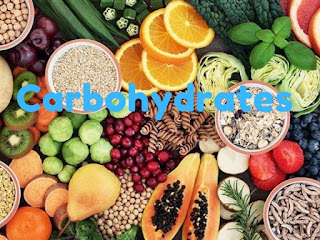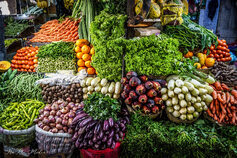In the current article, we will discuss the capabilities and benefits of a plant-based diet and its effect on health and nutrition
A Plant diet contains a high percentage of plant foods which are good for
health and nutrition instead of animal food. It can include food like nuts,
full grains, lentils, poultry, beans, fruits and vegetables. However, this diet
must not be strictly vegetarian.
First, a Plant diet is recognized as a core unit of nutrition as it values
natural, whole foods, rather than nutrients and calories. This is because of
the synergistic composition, which can take place only with whole products, of
vitamins, minerals, antioxidants and phytochemicals. Thus, moderate amounts of whole
foods in your diet make good sense to eat.
It is important for your health to always move around one vegetable, whole
grain or fruit for another until you get all kinds of phytochemicals well
within your body. Various parts of your body demand separate plant chemicals to
work; a healthy nutrient mix is, therefore, necessary for human health.
Veganism is a lifestyle defined by the elimination and opposition to animal
testing and cruel treatment of animal products from food and clothing. The diet
is based on plants and excludes meat. Although meat may appear missing from the
diet, a herbal diet can in fact provide all the essential nutrients that are
necessary to maintain good health and promote longevity.
Fruit, vegetables, nuts and seeds are part of a plant-based diet. Each
contains all the essential nutrients needed by the human body to promote
healthy digestion and function, heart disease, bone health, and even
psychiatric health. The calories, fat and cholesterol are low at the same time.
They contribute to weight maintenance and to adequate fibre, vitamin, carbs and
antioxidants.
The best way to ensure an adequate supply of all the nutrients required for
a healthy disposition is to vary the plant-based foods consumed. There are so
many to choose from, so the variation is greater than one might expect. Salads
and fresh fruit are included, but so are whole grain products, beans, oils,
herbs, and spices. These items, when combined, can be mixed and matched and
prepared in a variety of ways to provide the nutrients required for good health
without the need for supplements.
The essential nutrient such as amino acids, vitamins, protein, fibre, and
magnesium is present in Plant-based foods which are very beneficial for good
health. They can be found in a variety of foods. Some foods have a lot of one
nutrient but only a little of another, that's why a plant-based diet should be
varied.
Capabilities of a Plant-based diet
Some of the capabilities of a plant-based diet are;
Natural Food Colors
Furthermore, eating the colours is part of a plant-based diet. Combining
various colours and types of fruits and vegetables is both healthy and tasty.
Colors, in fact, provide information about the nutrients found in foods.
Red, for example, represents vitamin A (beta carotene) and vitamin C.
Following closely behind is yellow, which indicates potassium and fibre, and
green, which indicates iron or folic acid. Furthermore, blue and purple colours
indicate the presence of anthocyanins, which fight free radicals, while white
reflects vitamins and minerals.
Food's Healing Potential
Importantly, the healing power of whole fruits and vegetables in a
plant-based diet is available to you if you are willing to use it. This type of
healing, however, is rarely immediate; nature must be permitted to take its
course, and there are no wellness prophecies that happen overnight.
Meanwhile, processed foods in your diet can quickly undo all of the good
work done by natural foods. What you eat and don't eat is crucial if you want
to see tangible results.
Plants' Green Blood
When you eat plant foods with increased chlorophyll content, you are in a
sense, letting the sun into your life. Throughout in a real sense, your own red
blood flourishes on plant green blood. So, the more greens you have inside your
body, the more oxygen you will have to produce red blood cells. Just as trees
rely on their leaves for nutrition, you can get by on leafy greens.
Preparation of Food
Finally, a plant-based diet considers how foods are prepared or consumed;
thus, you should eat fresh or freshly cooked foods. In one case, a woman in
preventive detention was provided with reheated leftovers. Her health
deteriorated after that, and she lost all of her energy, making it impossible
for her to work full-time.
Benefits of Plant-based diet
There are many benefits of a plant-based diet, some of these benefits are discussed below.
The level of blood pressure
A plant-based diet is an excellent source of potassium-rich foods, which
can naturally help in reducing blood pressure. Fruits and vegetables, as well
as many other seeds, nuts, legumes, and whole grains, contain enough vitamin B6
and potassium to maintain healthy blood pressure. Animal foods, such as meat,
contain little potassium and can raise cholesterol and blood pressure.
When you consume fatty meats and dairy products, your blood viscosity
rises, putting a lot of pressure on your blood vessels. A plant-based diet
provides you with potassium-rich vegetables and fruits. A higher potassium
intake reduces blood viscosity. As a result, vegetarians and vegans have lower
rates of hypertension.
Sugar Levels
Increasing fibre in the diet is a highly effective way to control high
blood sugar. A fibre-rich diet is ideal for slowing sugar absorption in the
bloodstream. Another advantage is the ability to control hunger throughout the
day. Furthermore, fibre can aid in balancing the level of cortisol in the
bloodstream, which is responsible for stress-related feelings. Many animal
foods can contribute significantly to an increase in blood sugar levels.
Cholesterol
The ability to lower cholesterol is a significant advantage of following a
plant-based diet. Going green can significantly reduce the amount of LDL
cholesterol in your blood, which is the bad kind that can cause heart disease
and stroke.
Avoid butter, limit your intake of fatty meats, and eat more plant-based
foods. Dairy and animal products are high in fat and low in fibre. Plant-based
foods have no cholesterol at all. That means vegan diets are much preferable
for your heart and health.
Even the most saturated plants, such as cacao and coconut, are
cholesterol-free. As a result, eating a diet high in plant-based foods can
provide an easy method to lowering cholesterol. Seeds, nuts, whole grains,
fruits, and vegetables are excellent food choices for lowering the risk of
heart disease and cholesterol.
Loss of Weight
Those who eat a plant-based, vegan, or vegetarian diet consume fewer
calories and have lower body weights than those who do not. A plant-based diet,
however, does not guarantee weight loss.
A diet high in plant-based and whole foods, low in processed sugars, and
low in fat is certain to aid in weight loss. A diet rich in clean and raw whole
foods provides additional benefits.
You should limit your intake of sweets and fatty foods, choose whole
grains, eat a variety of fruits and vegetables, and opt for fat-free and
low-fat dairy products. Also, keep in mind that the method of cooking is
important. Instead of frying, steam, boil, grill, or roast. Your new diet will
even provide you with more energy for physical activity.
Weight loss occurs naturally when the daily diet contains a higher
percentage of vitamins, minerals, and fibre than proteins and animal fats. A
well-planned plant-based diet has the potential to lose 4-6 pounds in just two
weeks. This should also keep you from feeling hungry.
Anti Cancer
A plant-based diet rich in low-fat, whole foods is one of the most
effective ways to reduce the risk of cancer. Specific cancers, such as breast
and colon cancer, are more common in people who eat primarily animal foods.
High-fat diets have already been associated with an increased risk of
cancer. Meat has a high saturated fat content and a low fibre content. Fibre is
necessary for maintaining your digestive system clean and healthy, as it
removes cancer-causing compounds before they cause harm.
A vegetarian or vegan diet is high in fibre, low in saturated and trans
fats, and contains more fruits, vegetables, and other cancer-fighting
phytochemicals.
Major Nutrients in a plant-based diet
Calcium is a nutrient that the human body requires for strong teeth and
bones, but it is not produced or stored within the body. Leafy greens must be a
mainstay of a plant-based diet to get a sufficient quantity of calcium.
Spinach, kale, bok choy, collard, mustard, and turnip greens are among them.
Almonds and hazelnuts can be added to a meal to add calcium.
Iron is critical in the transport of oxygen to the body's organs. Leafy
greens are a good source of iron, but other foods will suffice as well. To get
enough iron on a plant-based diet, eat foods like oatmeal, whole wheat bread,
and lentils, among others. Consumption of iron-rich foods should be conducted
on a regular basis.
Vitamin B12 is a necessary vitamin, but it is scarce in plant-based diets.
B12 is available in fortified foods and supplements. This essential vitamin
helps with energy, reduces the risk of several diseases, and improves overall
mental health, so it should be a regular part of a plant-based diet.
Earth foods in their natural state are unaltered and thus healthier for
humans than animal-based and cooked foods. Adopting a plant-based diet can help
a person achieve great health and a well-balanced lifestyle with little
research and experimentation.
















.jpg)

